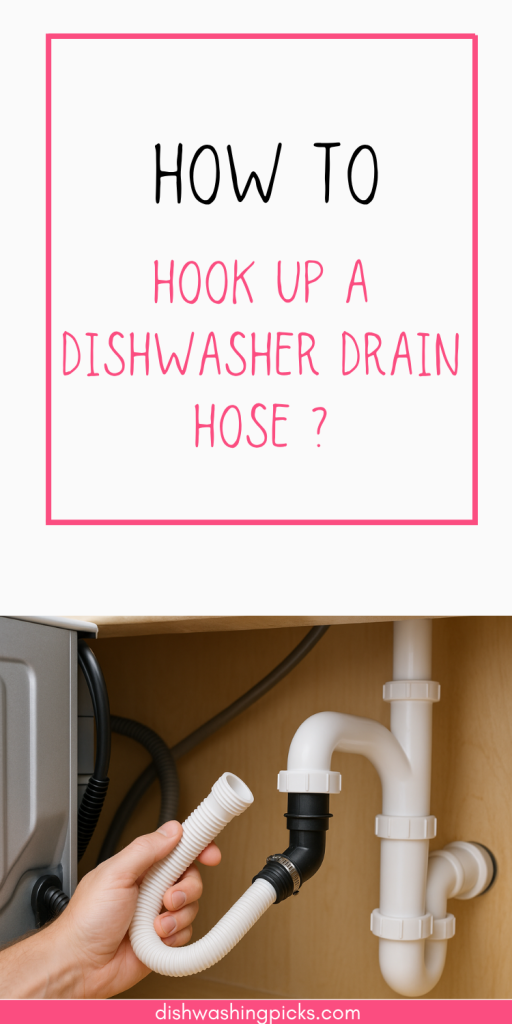
Let’s Set the Scene…
So, you’ve finally got yourself a dishwasher. Whether it’s a brand-new install or you’re swapping out an old clunker that’s been limping along for years, you’re one step closer to a life where “doing the dishes” means pressing a button and walking away. Glorious, right?
But hold on—before you can kick your feet up and toast to your sparkling-clean future, there’s one little hose that’s standing between you and dishwasher paradise.
Yep. The drain hose.
It might not look like much—just a flexible tube, nothing flashy—but it’s doing big work. Its job? To quietly carry all that dirty, soapy, greasy water away and out of your life. When it’s hooked up right, you don’t even think about it. When it’s not? Oh, you’ll definitely know.
We’re talkin’ leaks, backups, smells… the kind of drama nobody signed up for.
But don’t worry—you don’t need to be a plumber or own a belt full of tools. I got you. This guide will walk you through the whole thing like a buddy who’s done it a few times (and maybe messed it up once or twice before getting it right 😅).
What You’ll Need (And Nope, Nothing Fancy)
First things first—gather your stuff. No one likes crawling under the sink, realizing they forgot a tool, and having to wiggle back out again. Let’s make life easy.
Here’s what you’ll want nearby:
- ✅ The dishwasher drain hose (usually comes with the unit, but double-check)
- ✅ Hose clamps (sometimes called worm clamps or spring clamps)
- ✅ Pliers or a nut driver
- ✅ A bucket (because water likes to surprise you)
- ✅ A couple towels (you already know why)
- ✅ Zip ties or a strap for the high loop (we’ll get to that)
- ✅ A little patience and a can-do attitude 💪
That’s it! Nothing crazy.
Step 1: Locate the Two Places This Hose Will Connect
Okay, this part is easy. The drain hose has to connect from the dishwasher to your plumbing, right?
So where exactly?
- On the dishwasher side: You’ll find a short plastic stub near the back or bottom of the unit—that’s the drain outlet.
- On the sink side: Look under your sink. You’ll see either:
- A small inlet on the garbage disposal, or
- A separate drain pipe tailpiece connected to the sink drain.
- A small inlet on the garbage disposal, or
Oh, and if you’ve got an air gap on your sink (that little metal nub next to the faucet), the hose might run through that instead. Don’t worry, we’ll cover all the options.
🧠 Heads-up tip: If you’re hooking up to a garbage disposal and it’s brand new, there’s a little plastic knockout plug inside the inlet where the hose connects. You have to punch that thing out first, or the dishwasher won’t drain and you’ll think it’s broken. Don’t ask me how I learned that one.
Step 2: Connect the Hose to the Dishwasher
Let’s start with the easy side.
Take the end of the hose and push it onto the dishwasher outlet—make sure it’s all the way on. Then take a hose clamp and slide it over the connection. Tighten it up with a nut driver or pliers until it feels secure. Don’t overtighten—you don’t want to crack the plastic.
Give it a little tug. If it stays put, you’re good.
Boom. One side down.
Step 3: Create the High Loop (Seriously, Don’t Skip This)
Okay, so this is one of those things people skip because they don’t think it’s important—but it’s super important.
The high loop is a simple trick where you raise the drain hose up under the sink, near the underside of the countertop, before connecting it to the drain or disposal. It helps prevent gross sink water from flowing backward into the dishwasher.
Because… ew. No one wants that.
Here’s how you do it:
- Pull the hose up so it forms an upside-down U shape.
- Strap it in place under the counter using a zip tie or screw-in bracket.
- Make sure there’s no kink or twist—just a nice, smooth arc.
🎯 Think of it like giving your dishwasher a one-way street. Water goes out, but it can’t sneak back in.
If you’ve got an air gap, you can skip the high loop—it serves the same purpose and already has a built-in overflow protection system.
Step 4: Connect to the Drain or Garbage Disposal
You’re in the home stretch!
Depending on what your kitchen setup looks like, this part’s slightly different:
👉 If you’re connecting to a garbage disposal:
- Make sure you punched out that plug inside the disposal inlet (yep, I’m saying it twice—it’s that common of a mistake).
- Slide the hose onto the disposal nozzle.
- Add a clamp and tighten it down.
👉 If you’re connecting to a sink drain tailpiece:
- Find the little ¾” outlet (usually near the top of the vertical pipe).
- Slide the hose on.
- Clamp it tight.
Easy, right?
Just make sure everything feels snug. No one wants a surprise spray mid-cycle.
Step 5: Test for Leaks (A.K.A. The Truth Comes Out)
Now comes the moment of truth.
Before you push the dishwasher all the way back into place, run a short cycle or rinse cycle and watch it like a hawk.
- Look under the sink.
- Check the clamps.
- Peek under the dishwasher if you can.
If there’s a leak, it’s usually just a loose clamp or a hose that wasn’t pushed on far enough. Easy fix.
Once you’re sure everything’s dry and drama-free, slide the dishwasher into place carefully—watch the hose to make sure it doesn’t kink or fold behind the unit.
Bonus Tip: If the Hose is Too Long…
Sometimes manufacturers give you way more hose than you actually need, which is great… until you have a spaghetti tangle under your sink.
If it’s ridiculously long, you can trim the extra length off with a utility knife—but only after you’ve measured twice. Better to have a little slack than not enough. You don’t want to accidentally cut it too short and have to start begging a hardware store employee for a replacement part at 7pm.
Final Thoughts: You’re Basically a Dishwasher Whisperer Now
And that’s it! You just hooked up a drain hose like a pro. Sure, it might not make you feel like a superhero, but your future self—who never has to mop up soapy water from under the cabinets—will thank you.
It’s not glamorous work. No one’s writing songs about drain hoses. But it’s the kind of stuff that keeps your home running smooth and your kitchen drama-free.
And now? You can officially say you’ve conquered the under-sink jungle.
So go ahead. Grab a drink. Press that first cycle button. And listen to the beautiful hum of a dishwasher doing its thing—no leaks, no clogs, no surprises.
You did that. 🙌
